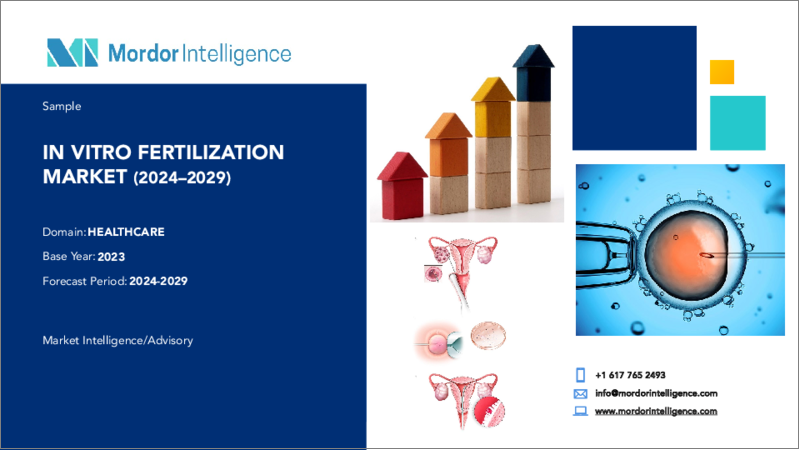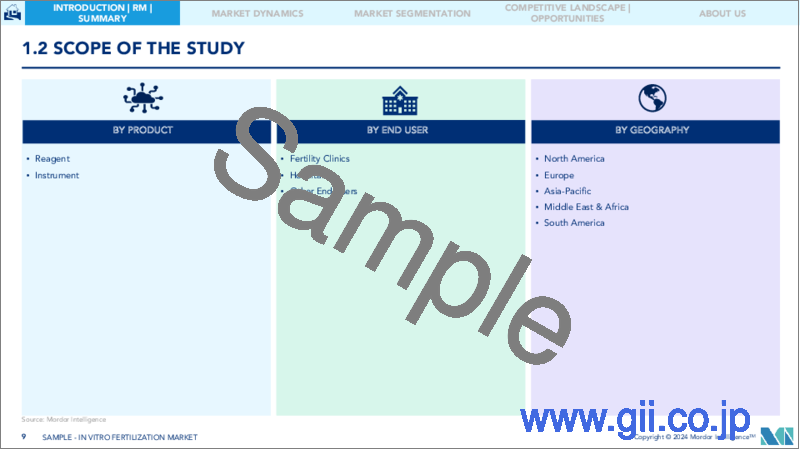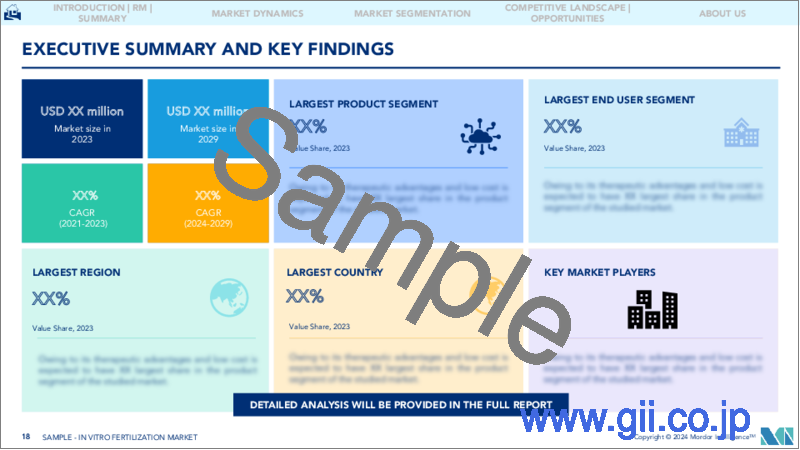|
|
市場調査レポート
商品コード
1403102
体外受精-市場シェア分析、産業動向と統計、2024~2029年の成長予測In Vitro Fertilization - Market Share Analysis, Industry Trends & Statistics, Growth Forecasts 2024 - 2029 |
||||||
カスタマイズ可能
適宜更新あり
|
|||||||
| 体外受精-市場シェア分析、産業動向と統計、2024~2029年の成長予測 |
|
出版日: 2024年01月04日
発行: Mordor Intelligence
ページ情報: 英文 110 Pages
納期: 2~3営業日
|
全表示
- 概要
- 目次
体外受精市場規模は2024年に264億7,000万米ドルと推定・予測され、2029年には385億2,000万米ドルに達し、予測期間中(2024~2029年)にCAGR 8.20%で成長すると予測されます。
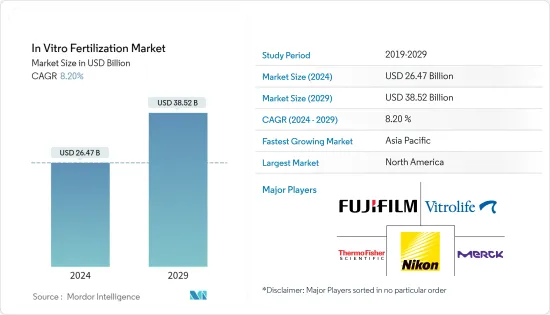
COVID-19の流行は、体外受精治療の一時停止により調査市場の成長に影響を与え、体外受精を受ける女性に大きな影響を与えました。例えば、Reproductive Biomedicine and Society Onlineに掲載された論文によると、パンデミックは、クリニックの閉鎖に起因する欧州での大規模な生殖補助技術治療の停止をもたらし、その結果、この地域、特に英国で数千人の患者の不妊治療が遅れました。このように、治療の中断はパンデミック期間中の市場の成長に影響を与えました。しかし、規制が解除され、治療手順中に適切な消毒と測定が行われるようになったため、体外受精の需要は増加しています。このように、調査された市場は大きな成長を示しており、予測期間中に成長すると予想されます。
体外受精技術の成功率の上昇、体外受精手順に関する認知度の向上、妊娠開始の遅れなどの要因が、予測期間中の市場成長を後押しすると予想されます。
不妊症は、生殖機能の障害に関連する環境、遺伝、年齢、合併症などの複数の要因によって、世界の課題として増加し続けています。不妊症患者数の増加により、子供を妊娠することが困難または不可能なカップルを支援する不妊治療に対する需要が高まっています。例えば、2022年5月にCell誌に掲載された論文によると、男性不妊症は、世界の不妊カップルの約半数に影響を及ぼす、増加しつつある深刻な医学的懸念であることが観察されています。また、2022年3月に国際法曹協会(International Bar Association)に掲載された論文によると、世界の先進諸国では出生率が一貫して代替水準を下回るまで低下しています。このため、不妊症治療のための体外受精の需要が高まり、市場の成長が促進されると予想されます。
さらに、不妊治療、治療オプション、不妊問題の要因について一般市民を啓蒙するために、政府やその他の団体がいくつかのキャンペーンを展開する取り組みが活発化しています。例えば、2022年8月、Pinnacle Fertility社は、家族を築く治療を脅かす潜在的な新しい法律について啓蒙するSave IVFキャンペーンを開始しました。また、2022年7月には、Oasis Fertilityが世界IVFデーを記念して「不妊に性別はない」キャンペーンを開始しました。体外受精は、不妊に悩む何100万ものカップルに希望の光を与えます。
さらに、より良いARTサービスを提供するために、世界中で体外受精施設や新技術の導入が増加していることも、同分野の成長に寄与しています。例えば、2022年8月、Rejuvenating Fertility Center(RFC)は、注射不要の体外受精(Injection-Free IVF)または針不要の体外受精(Needle-Free IVF)を開始しました。この非従来型のホリスティック治療は、体外受精(IVF)中に患者の卵巣を刺激するために経口と経鼻排卵誘発剤を使用します。これにより卵巣が穏やかに刺激され、より質の高い卵子が複数産み出されます。このような開発により、無針体外受精治療の需要が増加すると予想されます。
したがって、不妊症の高い負担、体外受精啓発キャンペーンの増加、体外受精施設や製品の増加といった上記の要因により、調査対象市場は予測期間中に成長すると予想されます。しかし、体外受精に関連する合併症、社会的烙印、体外受精に関連する倫理的・法的問題が、予測期間中の市場成長の妨げになる可能性が高いです。
体外受精市場の動向
精子分離システム部門は予測期間中に大幅な成長が見込まれる
体外受精(IVF)や人工授精など、ほとんどの生殖補助医療(ART)では、精子分離システムが使用されます。これらのシステムは、精製されたサンプルを提供し、その後の処置に使用できるため、生殖補助医療(ART)にとって極めて重要です。これらのシステムは、その後の処置に使用できる精製されたサンプルを提供するため、生殖補助医療(ART)にとって極めて重要です。さらに、不妊治療クリニックや産婦人科医(OB/GYN)が実施する生殖補助医療(ART)処置で使用する新規機器の開発に企業が注力する傾向が高まっていることも、市場の成長を後押ししています。
高品質の精子を選別するために、精子シリンジなどの先端技術の使用が増加していることが、同分野の成長を促進すると予想されます。例えば、2022年3月にAdvanced Materials Technologies誌に掲載された論文によると、精子シリンジは1.5mlの精液サンプルと選別事象の間に最大接触面積を提供し、それによって高度に並列化された迅速な選別機構を可能にします。この回収効率は、より侵襲的な卵細胞質内精子注入法(ICSI)を避けるために、液滴ベースの体外受精や子宮内人工授精(IUI)に十分な量と数の高品質精子を提供します。
また、精子シリンジは、クリニックがより侵襲性の低い生殖補助医療(ART)を導入するための有望な選択肢を提供し、したがって、関連する臨床的負担を最小限に抑え、顕微授精と比較してARTで妊娠した子供の長期的な健康転帰を改善します。
さらに、精子分離分野における技術的進歩の拡大も、同分野の成長に寄与しています。例えば、2022年3月、マルタはユニバーシティ・シティ・サイエンス・センターのPera Labsの商品化アドバイザーと共同で、不妊治療用のAIを搭載した精子・卵子選別技術の研究開発を開始しました。Pera Labsのマルタでの事業は、マルタ・エンタープライズからの80万ユーロ(88万3,040米ドル)の財政支援とPera Labsの資金調達が相まって加速しています。
したがって、技術の急速な進歩と精子選別手順の正確さにより、精子分離システム部門は予測期間中に大きな成長を遂げると予想されます。
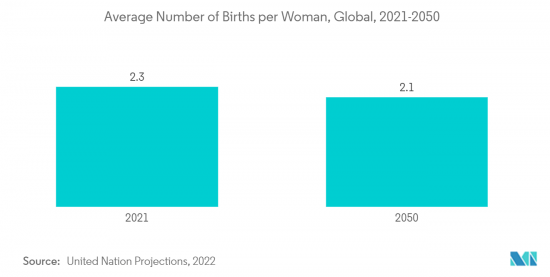
予測期間中、北米が大きな市場シェアを占める見込み
北米は、多嚢胞性卵巣症候群(PCOS)などの関連疾患の有病率の上昇、手順の標準化、精子と卵子の保存に対する政府からの資金援助、男女ともに不妊症の発生率の恒常的な上昇などの要因から、予測期間にわたって市場で大きなシェアを占めると予想されます。加えて、この地域には様々な大手企業が存在すること、独身女性や同性カップルの数が増加していること、有利な規制改革もこの地域の市場成長を後押しすると予想されます。
同国では独身女性や同性カップルの数が増加しているため、親になるための体外受精治療の需要が高まっており、これが市場成長を後押しすると予想されます。例えば、米国国勢調査が発表した2022年のデータによると、米国では2021年に約120万組の同性カップルが生活しており、そのうち71万組(60%)が既婚、50万組が未婚でした。さらに、同地域における体外受精の件数が増加していることも、市場の成長に寄与しています。例えば、米国では2021年に約36万8,502回のARTが実施され、前年比19%増となった。
さらに、喫煙、飲酒、一部の違法薬物の使用、肥満などの根本的な問題の増加により、不妊症の発生率が増加しています。例えば、WHOが発表した2021年のデータによると、カナダでは12%の人が定期的に喫煙しており、15歳から19歳の人(4%)に比べ、20歳以上の人の喫煙率が最も高い(11%)。喫煙率の上昇は、精液中のフェロプターシスの高さと関連しており、精液の質に影響を与え、妊娠の確率を低下させる。
企業による買収や提携など、さまざまな事業戦略の採用の増加は、高度不妊治療センターやオプションの導入を増加させ、市場成長を促進すると予想されます。例えば、2022年12月、Kindbody社はダラスに最先端のクリニックと体外受精(IVF)ラボを開設し、同地域の患者や雇用者による世界クラスの不妊治療と包括的な家族形成のための福利厚生に対する需要の増加に対応しました。
同様に、Cooper Companiesは2021年12月、不妊治療用のドナー卵子と精子、不妊治療用凍結保存サービス、新生児幹細胞保存(臍帯血と臍帯組織)を提供するGenerate Life Sciencesを約16億米ドルで買収しました。この買収により、CooperSurgicalは、不妊治療クリニック、産科、婦人科に、より強力なサービスと製品を提供することができます。
したがって、上記の要因により、調査対象市場は予測期間中に成長すると予想されます。
体外受精産業概要
体外受精市場は、世界的と地域的に事業を展開する複数の企業の存在により、その性質上、統合されています。主要企業は、体外受精市場での地位を維持するために、買収、提携、パートナーシップ、新製品の発売などの重要な戦略的活動を採用しています。同市場の主要企業としては、Thermo Fisher Scientific Inc.、Vitrolife AB, Fujifilm Holdings Corporation、Merck KGaA、Nikon Corporation、Cooper Surgical Inc.、Boston IVFなどが挙げられます。
その他の特典:
- エクセル形式の市場予測(ME)シート
- 3ヶ月間のアナリスト・サポート
目次
第1章 イントロダクション
- 調査の前提条件と市場定義
- 調査範囲
第2章 調査手法
第3章 エグゼクティブサマリー
第4章 市場力学
- 市場概要
- 市場促進要因
- 体外受精技術の成功率の上昇
- 体外受精技術に対する意識の高まり
- 妊娠成立の遅れ
- 市場抑制要因
- 体外受精に伴う合併症
- 体外受精に関連する社会的烙印、倫理的、法的問題
- ポーターのファイブフォース分析
- 買い手/消費者の交渉力
- 供給企業の交渉力
- 新規参入業者の脅威
- 代替品の脅威
- 競争企業間の敵対関係の強さ
第5章 市場セグメンテーション(市場規模-米ドル)
- 製品別
- 試薬
- 機器
- イメージングシステム
- インキュベーター
- クライオシステム
- IVFキャビネット
- 卵子吸引ポンプ
- 精子分離システム
- マイクロマニピュレーターシステム
- その他の機器
- エンドユーザー別
- 不妊治療クリニック
- 病院
- その他のエンドユーザー
- 地域別
- 北米
- 米国
- カナダ
- メキシコ
- 欧州
- ドイツ
- 英国
- フランス
- イタリア
- スペイン
- その他の欧州
- アジア太平洋
- 中国
- 日本
- インド
- オーストラリア
- 韓国
- その他のアジア太平洋
- 中東・アフリカ
- GCC諸国
- 南アフリカ
- その他の中東とアフリカ
- 南米
- ブラジル
- アルゼンチン
- その他の南米
- 北米
第6章 競合情勢
- 企業プロファイル
- Cook Group Incorporated
- CooperSurgical Inc.
- Fujifilm Holdings Corporation
- Genea Biomedx Pty Ltd
- Hamilton Thorne Ltd
- Merck KGaA(EMD Serono Inc.)
- Nikon Corporation
- Thermo Fisher Scientific Inc.
- Vitrolife AB
- Oxford Gene Technology(Sysmex Corporation)
- Rocket Medical PLC
第7章 市場機会と今後の動向

The In Vitro Fertilization Market size is estimated at USD 26.47 billion in 2024, and is expected to reach USD 38.52 billion by 2029, growing at a CAGR of 8.20% during the forecast period (2024-2029).
The COVID-19 pandemic has impacted the growth of the studied market owing to the suspension of in vitro fertilization treatments, and this had a profound impact on women undergoing IVF procedures. For instance, according to an published in Reproductive Biomedicine and Society Online, the pandemic has resulted in the large-scale cessation of assisted reproductive technology treatment in Europe owing to the closure of clinics, which resulted in delayed fertility treatment of thousands of patients in the region, especially the United Kingdom. Thus, the disrupted treatment has impacted the growth of the market during the pandemic period. However, with released restrictions and proper sanitization and measurements taken during the treatment procedures, the demand for in-vitro fertilization has increased. Thus, the studied market has witnessed significant growth and is expected to grow over the forecast period.
Factors such as the rising success rate of IVF technology, increasing awareness about IVF procedures, and delayed onset of pregnancy are expected to boost market growth over the forecast period.
Infertility continues to represent an increasing global challenge due to multiple factors such as environment, genetics, age, and comorbidities associated with impaired reproductive function. The rising number of infertile cases has increased the demand for fertility procedures that help couples with difficulties or an inability to conceive children. For instance, according to an article published in Cell in May 2022, it has been observed that male infertility is an increasing and serious medical concern that affects approximately half of infertile couples worldwide. Also, an article published in the International Bar Association in March 2022 showed that fertility rates have consistently declined to below replacement levels across developed countries globally. This is anticipated to fuel the demand for in-vitro fertilization to treat infertility issues, propelling the market growth.
Additionally, there is a growing effort by the government and other organizations to launch several campaigns to educate the public about fertility care, treatment options, and the factors contributing to infertility issues. For instance, in August 2022, Pinnacle Fertility launched the Save IVF campaign to educate on potential new legislation that threatens family-building treatment. Also, in July 2022, Oasis Fertility launched the Infertility Knows No Gender campaign to commemorate World IVF Day. IVF offers a ray of hope to millions of couples struggling with infertility.
Furthermore, the increasing launches of IVF facilities and new technologies across the globe for providing better ART services are also contributing to segment growth. For instance, in August 2022, the Rejuvenating Fertility Center (RFC) launched Injection-Free IVF or Needle-Free IVF procedures. This non-conventional holistic treatment uses oral and nasal fertility drugs to stimulate the patient's ovaries during in vitro fertilization (IVF). This gently stimulates the ovaries to produce multiple higher-quality eggs. Such developments are expected to increase the demand for needleless IVF treatment.
Therefore, owing to the factors above, such as the high burden of infertility, increasing IVF awareness campaigns, and the growing number of IVF facilities and products, the studied market is anticipated to grow over the forecast period. However, the complications associated with in-vitro fertilization, social stigma, and ethical and legal issues associated with in-vitro fertilization are likely to hinder the market's growth over the forecast period.
In Vitro Fertilization Market Trends
The Sperm Separation Systems Segment is Expected to Witness Significant Growth Over the Forecast Period
In most assisted reproductive technologies (ART), such as in vitro fertilization (IVF) and artificial insemination, sperm separation systems are used. These systems are critical for assisted reproductive technologies (ARTs) because they provide purified samples that can be used in subsequent procedures. These systems are crucial for ARTs as they provide purified samples for further procedures. Furthermore, the rising focus of companies on developing novel devices for use in assisted reproductive technology (ART) procedures conducted by fertility clinics and obstetrician-gynecologist (OB/GYN) practices is driving the market growth.
The increasing use of advanced technology, such as sperm syringes, in selecting high-quality sperm is expected to fuel the segment growth. For instance, an article published in Advanced Materials Technologies in March 2022 reported that a sperm syringe provides the maximum contact area between 1.5 ml of the semen sample and selection events, thereby enabling a highly parallelized and rapid sorting mechanism. This retrieval efficiency provides a sufficient volume and number of high-quality sperm for droplet-based IVF and intrauterine insemination (IUI) to avoid the more invasive intracytoplasmic sperm injections (ICSI) procedure.
Also, sperm syringe offers a promising option for clinics to deploy less invasive assisted reproductive technologies (ARTs), hence minimizing the related clinical strain and improving the long-term health outcomes for ART-conceived children as compared to intracytoplasmic sperm injection.
Furthermore, the growing technological advancements in the sperm separation segment are also contributing to the segment's growth. For instance, in March 2022, Malta, in collaboration with Pera Labs's commercialization advisors at the University City Science Center, started the research and development of an AI-powered sperm and egg selection technology for fertility treatments. Pera Labs's Malta operations are accelerated by the EUR 800,000 (USD 8,83,040) of financial support from Malta Enterprise, coupled with Pera Labs's financing.
Therefore, due to the rapid advancements in technology and the accuracy of sperm selection procedures, the sperm separation systems segment is expected to witness significant growth over the forecast period.

North America is Expected to Have the Significant Market Share Over the Forecast Period
North America is anticipated to hold a significant share of the market over the forecast period owing to factors such as the rising prevalence of associated conditions such as polycystic ovary syndrome (PCOS), standardization of procedures, government funding for sperm and egg storage, and a constant rise in the incidence of infertility in both sexes. In addition, the presence of various leading players in this region, the growing number of single women and same-sex couples, and favorable regulatory reforms are also expected to boost the market growth in the region.
The rising number of single women and same-sex couples in the country are increasing the demand for IVF treatment to help them become parent, which is expected to fuel the market growth. For instance, according to the 2022 data published by the United States Census, about 1.2 million same-sex couples were living in the United States in 2021, of which 710,000 (60%) were married and 500,000 were unmarried. Additionally, the rising number of in-vitro fertilization procedures in the region contributes to the market growth. For instance, about 368,502 ART cycles were performed in the United States in 2021, an increase of 19% compared to the previous year.
Additionally, the incidence of infertility is increasing due to rising levels of smoking, alcohol consumption, use of some illicit drugs, and underlying problems, including obesity. For instance, as per the 2021 data published by the WHO, 12% of the people in Canada smoke regularly, and people aged 20 years or above have the highest rate of smoking (11%) as compared to people aged 15 years to 19 years (4%). The rising prevalence of smoking is associated with a high level of ferroptosis in seminal plasma, which affects the quality of semen and lowers the probability of getting pregnant, which is expected to propel the growth of the studied market over the forecast period.
The increasing adoption of various business strategies such as acquisitions, partnerships, and others by the companies increases the introduction of advanced fertility treatment centers and options, which is anticipated to propel market growth. For instance, In December 2022, Kindbody launched a state-of-the-art clinic and in vitro fertilization (IVF) lab in Dallas to meet the increasing demand for world-class fertility care and comprehensive family-building benefits by patients and employers in the area.
Similarly, in December 2021, Cooper Companies acquired Generate Life Sciences, a provider of donor eggs and sperm for fertility treatments, fertility cryopreservation services, and newborn stem cell storage (cord blood and cord tissue) for approximately USD 1.6 billion. With this acquisition, CooperSurgical can offer fertility clinics, Obstetrics, and Gynaecology even stronger services and products.
Therefore, owing to the factors above, the studied market is anticipated to grow over the forecast period.
In Vitro Fertilization Industry Overview
The in-vitro fertilization market is consolidated in nature due to the presence of several companies operating globally as well as regionally. The key players are adopting key strategic activities such as acquisitions, collaborations, partnerships, and new product launches to withhold their position in the in-vitro fertilization market. Some of the key companies in the market are Thermo Fisher Scientific Inc., Vitrolife AB, Fujifilm Holdings Corporation, Merck KGaA, Nikon Corporation, Cooper Surgical Inc., and Boston IVF, among others.
Additional Benefits:
- The market estimate (ME) sheet in Excel format
- 3 months of analyst support
TABLE OF CONTENTS
1 INTRODUCTION
- 1.1 Study Assumptions and Market Definition
- 1.2 Scope of the Study
2 RESEARCH METHODOLOGY
3 EXECUTIVE SUMMARY
4 MARKET DYNAMICS
- 4.1 Market Overview
- 4.2 Market Drivers
- 4.2.1 Rising Success Rate of IVF Technology
- 4.2.2 Increasing Awareness about IVF Technology
- 4.2.3 Delayed Onset of Pregnancies
- 4.3 Market Restraints
- 4.3.1 Complications Associated with In Vitro Fertilization
- 4.3.2 Social Stigma, Ethical, and Legal Issues Associated with In Vitro Fertilization
- 4.4 Porter's Five Forces Analysis
- 4.4.1 Bargaining Power of Buyers/Consumers
- 4.4.2 Bargaining Power of Suppliers
- 4.4.3 Threat of New Entrants
- 4.4.4 Threat of Substitute Products
- 4.4.5 Intensity of Competitive Rivalry
5 MARKET SEGMENTATION (Market Size by Value - USD)
- 5.1 By Product
- 5.1.1 Reagent
- 5.1.2 Instrument
- 5.1.2.1 Imaging Systems
- 5.1.2.2 Incubators
- 5.1.2.3 Cryosystems
- 5.1.2.4 IVF Cabinet
- 5.1.2.5 Ovum Aspiration Pump
- 5.1.2.6 Sperm Separation Systems
- 5.1.2.7 Micromanipulator Systems
- 5.1.2.8 Other Instruments
- 5.2 By End User
- 5.2.1 Fertility Clinics
- 5.2.2 Hospitals
- 5.2.3 Other End Users
- 5.3 Geography
- 5.3.1 North America
- 5.3.1.1 United States
- 5.3.1.2 Canada
- 5.3.1.3 Mexico
- 5.3.2 Europe
- 5.3.2.1 Germany
- 5.3.2.2 United Kingdom
- 5.3.2.3 France
- 5.3.2.4 Italy
- 5.3.2.5 Spain
- 5.3.2.6 Rest of Europe
- 5.3.3 Asia-Pacific
- 5.3.3.1 China
- 5.3.3.2 Japan
- 5.3.3.3 India
- 5.3.3.4 Australia
- 5.3.3.5 South Korea
- 5.3.3.6 Rest of Asia-Pacific
- 5.3.4 Middle East and Africa
- 5.3.4.1 GCC
- 5.3.4.2 South Africa
- 5.3.4.3 Rest of Middle East and Africa
- 5.3.5 South America
- 5.3.5.1 Brazil
- 5.3.5.2 Argentina
- 5.3.5.3 Rest of South America
- 5.3.1 North America
6 COMPETITIVE LANDSCAPE
- 6.1 Company Profiles
- 6.1.1 Cook Group Incorporated
- 6.1.2 CooperSurgical Inc.
- 6.1.3 Fujifilm Holdings Corporation
- 6.1.4 Genea Biomedx Pty Ltd
- 6.1.5 Hamilton Thorne Ltd
- 6.1.6 Merck KGaA (EMD Serono Inc.)
- 6.1.7 Nikon Corporation
- 6.1.8 Thermo Fisher Scientific Inc.
- 6.1.9 Vitrolife AB
- 6.1.10 Oxford Gene Technology (Sysmex Corporation)
- 6.1.11 Rocket Medical PLC
